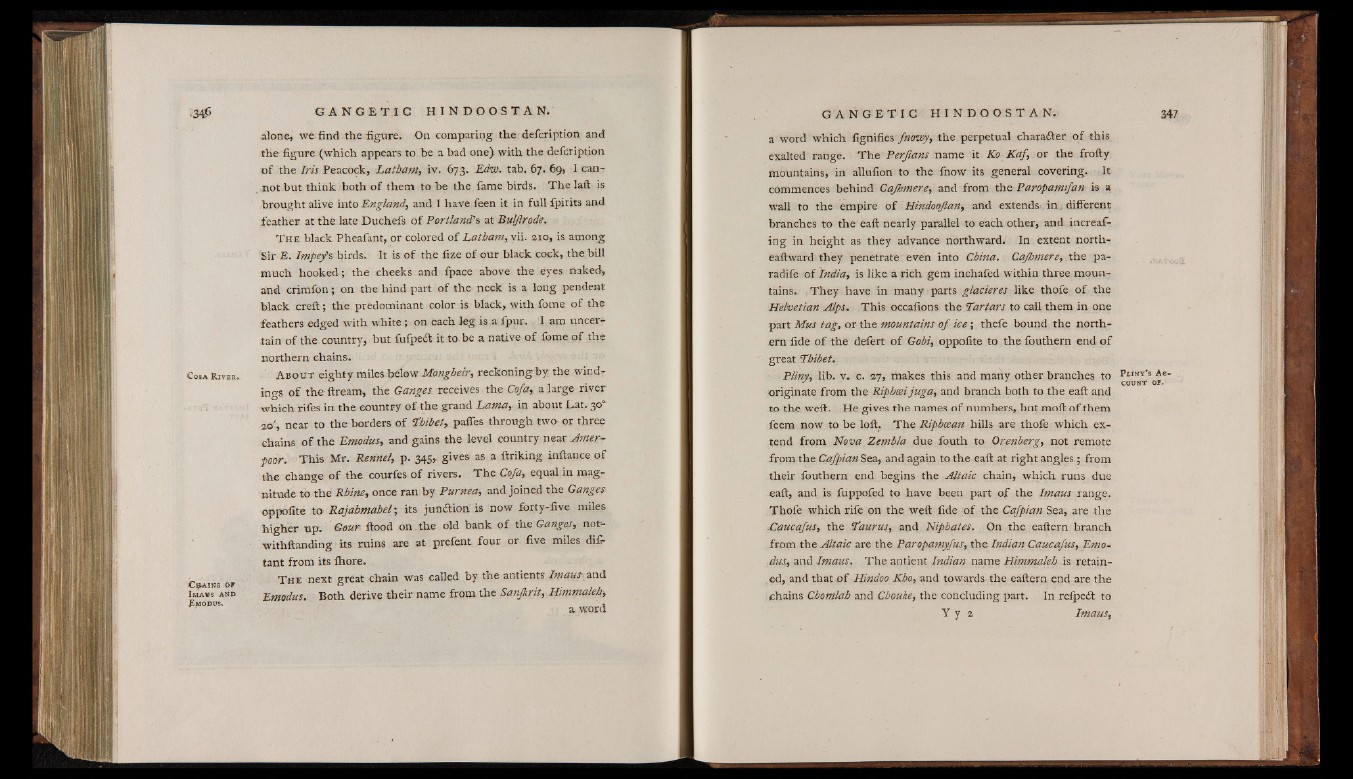
C osa Riv er ..
-C h a i n s o f
Im a v s a n d
E jm o d u s .
alone, we find the figure. On comparing the defcription and
the figure (which appears to be a bad one) with the defcription
o f the Iris Peacock, Latham, iv. 673. Edw. tab. 67. 69, 1 cannot
but think both of them to be the fame birds. The laft is
brought alive into Eng/and, and I have feen it in full fpirits and
feather at the late Duchefs o f Portland's at Buljirode.
T he black Pheafant, or colored of Latbam, vii. 210, is among
Sir E. Impe/s birds. It is o f the fize of our black cock, the bill
much hooked; the cheeks and fpace above the eyes naked,
and crimfon; on the hind part o f the neck is a long pendent
black creft; the predominant color is black, with fome of the
feathers edged with white ; on each leg is a l'pur. I am uncertain
of the country, but fufpecft it to be a native o f fome o f the
northern chains.
A bout eighty miles below Mongheir, reckoning by the wir d-
ings o f the ftream, the Ganges receives the Co/a, a large river
which rifes in the country o f the grand Lama, in about Hat. 30-
20', near to the borders o f Thibet, pafies through two or three
chains of the Emodus, and gains the level country near Amer-
poor. This Mr. Rennet, p. 345, gives as a ftriking inftance of
the change o f the courfes o f rivers. The Co/a, equal in magnitude
to the Rhine, once ran by Purnea, and joined the Ganges
oppofite to Rajahmahel; its junction is now forty-five miks
higher up. Gour- flood on the old bank of the Ganges, not-
withftanding its ruins are at prefent four or five miles distant
from its ihore.
T h e next great chain was called by the antients Imaus. and
Emodus. Both derive their name from the San/krit, Himmaleh,
a word
G A N G E T I C H I N D O O S T A N.
a word which fignifies /«owy, the perpetual charailer of this
exalted range. The Per/tans name it Ko KaJ, or the frofty
mountains, in allufion to the fnow its general covering, It
commences behind Cajhmere, and from the Paropamt/an is a
wall to the empire o f Hindoo/tan, and extends in , different
branches to the eaft nearly parallel to each other, and increasing
in height as they advance northward. In extent north-
eaftward they penetrate even into China. Cajhmere, the pa-
radife of India, is like a rich gem inchafed within three mountains.
They have in many parts glacieres like thofe of the
Helvetian Alps. This occafions the Tartars to call them in one
part Mus tag, or the mountains o f ic e ; thefe bound the northern
fide of the defert o f Gobi, oppofite to the fouthern end o f
great Thibet.
Pliny, lib. v. c. 27, makes this and many other ‘ J branches to Ac" COUNT o r .
originate from the Riphoei juga, and branch both to the eaft and
to the weft. He gives the names o f numbers, but moft o f them
feem now to be loft. The Ripbcean hills are thofe which extend
from Nova Zembla due fouth to Orenberg, not remote
from the Ca/pian Sea, and again to the eaft at right angles; from
their fouthern end begins the Altaic chain, which runs due
eaft, and is fuppofed to have been part of the Imaus range.
Thofe which rife on the weft fide o f the Ca/pian Sea, are the
.Cauca/us, the Taurus, and Nipbates. On the eaftern branch
from the Altaic are the Paropamy/us, the Indian Cauca/us, Emo-
dus., and Imaus. The antient Indian name Himmaleh is retained,
and that o f Hindoo Kbo, and towards the eaftern end are the
chains Chomlab and Cbouke, the concluding part. In refpecft to
Y y 2 Imaus,